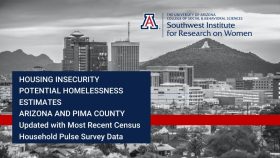
The University of Arizona Southwest Institute for Research on Women has released its most recent update to its report on Housing Insecurity Indicators and Potential Homelessness Estimates for Arizona and Pima County. This report measures current housing insecurity with newer census data.
This most recent survey wave contains multiple pieces of concerning news.
- Despite hardship caused by inflation, the positive macroeconomic situation has continued to hold steadily at the national and state levels (AZ unemployment has increased very modestly in recent months, but remains well below historical averages). In the previous survey wave, collected January 4th-16th 2023, the proportion of non-current renters was 11.2%. In the most recent survey, conducted February 1st–13th 2023, this proportion held steady at 11.0%. Rising rents and inflation are the likely the central drivers of this, especially for households with limitations on their ability to benefit from the strong labor market.
- In the previous report from early-January, 52% of non-current renters had not applied for rental assistance, this proportion rose to 76% in the most recent wave. Across those two survey waves, the proportion of non-current renters reporting having applied and received assistance fell from 25% to 1%. This suggests that fewer non-current renters are seeking out and receiving rental assistance (as we might expect given the expiration of rental assistance funds).
- Counts of calls to 211 from Pima County indicate a substantial increase in calls related to housing and shelter, utilities, and food requests in the last 6-8 months.
- Figures from Maricopa’s HMIS data indicate a 10% increase in the total number of people experiencing homelessness in Maricopa County between January and December of 2022 (and a 20% increase in the “balance of the state”, the areas outside of Maricopa and Pima counties).”
There is continuing good news to report on rents.
- Tucson rent prices have been decreasing, albeit very modestly, in recent months. This reversal of recent trends is a very welcome relief, but does not erase the increases in average and median rents experienced over the past three years (which remain the area of 37-38% even after including the small recent declines in median rents, Jan 2020-Jan2023). Statewide 68% of Arizona renters reported an increase in their monthly rent in the last year and 56% reported an increase of $100 or more. Disparities in financial strain along the lines of household incomes have increased in this and recent survey waves. Measures of households not being current on rental payments and those experiencing great difficulty meeting spending needs indicate that lower-income and BIPOC households in Arizona are slipping behind disproportionately.
